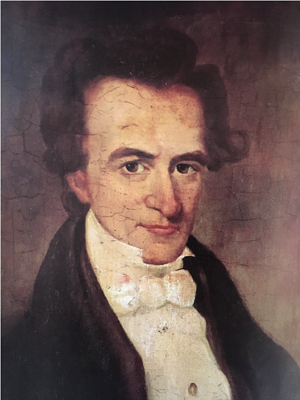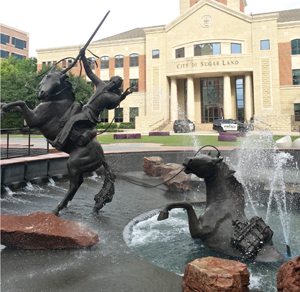A LITTLE PIECE OF HISTORY | By Joan Frances –

Stephen F. Austin.
When the subject of Texas history is discussed, one name stands out among all the other famous historians. His statue proudly stands at Town Square in Sugar Land. His name honors the State Capital, as well as many high schools, colleges, streets and parks throughout Texas. Stephen F. Austin is one of the most prominent founding fathers of the state. He is known for playing a key role in the colonization of Texas, as well as when Texas seceded from Mexico. He was only 27 years-old when he inherited the project of colonizing Texas from his father, Moses, and lived his adult life committed to making this dream come true.
Stephen Fuller Austin was born on November 3, 1793 in Virginia. He was the third child of Moses Austin and Mary Brown. Moses was a businessman and lead mine owner. When Moses lost his fortune in the mining business, he traveled to Texas and secured permission from the Spanish authorities to bring a group of settlers to begin life in the rugged and beautiful land of Texas. Unfortunately, Moses fell ill and died in 1821. His final wish was for his son to complete his settlement project. When Mexico achieved independence, Austin had to re-negotiate his father’s grant. Financially broke, he persevered, and by 1830, he succeeded in establishing a thriving colony of mostly Americans, looking for a new way of life.
Austin’s first grant, 58 of the original 300 colonists, settled in the Fort Settlement area, which is now the present-day Fort Bend County. The price per acre was only a few pennies; each settler paid $190 in fees to the state, the land commissioner and the surveyor for the deed. Each settler was granted one labor of 177 acres of farmland and one league consisting of 4,428 acres of pastureland. Families were required to build a permanent structure on the land, be of strong moral character and to be Catholic. Most of the colonists who came from the southern states were veteran farmers and rancher’s intent on growing corn, cotton and raising cattle.

Stephen F. Austin’s statue at the Sugar Land Town Square by Bob Pack.
Photo by Joey Belleza.
In 1833, Austin went to Mexico City to discuss new demands from the Texas settlers. He sent letters home encouraging the settlers to begin declaring statehood before the approval of the federal government. These letters were intercepted by the Mexico City officials, and Austin was jailed for a year and a half. When he was released, he set out to support Texas, essentially leaving Mexico to become a part of the United States or to declare independence. Not long after his return to Texas, the revolution began. Austin was a hardworking, brilliant man, a skillful colony administrator, and the most influential voice for working things out with Mexico, but he was not a military leader. After attempting to lead the Texas army to San Antonio, he quickly and happily turned the command over to Sam Houston, who was much more suited for the job.
Austin went on to become the Texas envoy to the United States. He traveled to Washington, giving speeches to encourage volunteers to go to Texas and to meet with officials. On April 21, 1836 at the Battle of San Jacinto, Texas gained independence, and Austin returned home. He was appointed the first Secretary of State by the first President of the Republic of Texas, Sam Houston. On December 27, 1836, Austin fell ill with pneumonia and died. In the eyes of the people of Texas, Stephen Fuller Austin was one of their greatest heroes. His insight, commitment and fortitude made Texas one of the most prosperous states in the union.